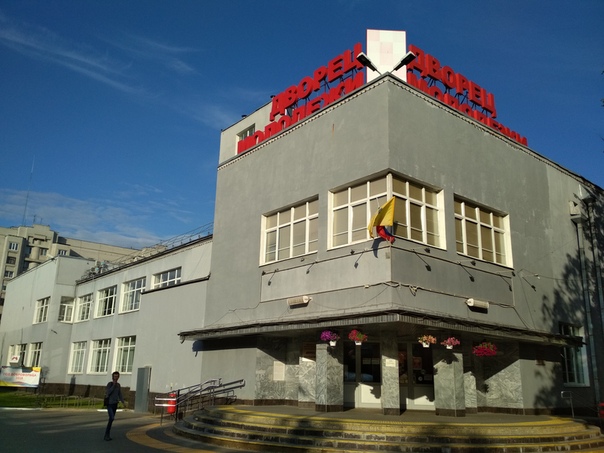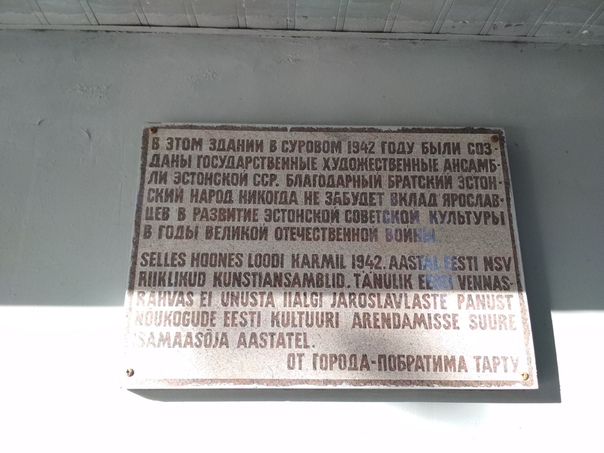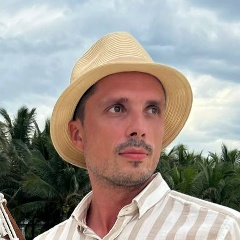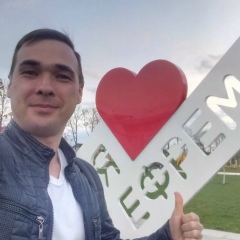Всем привет из Ярославля! Сегодняшний выпуск #estonian_challenge для [id2940906|Олька Winter] я буду вести прямо из него, ведь Ярославль одно время был культурной столицей Эстонии! Недолго, спонтанно и совсем не по своей воле, но вот как это было.
В 1941 году, когда Эстонию, на тот момент уже год как советскую, оккупировали немцы, именно сюда, в Ярославль, были эвакуированы музыканты, художники, актеры, писатели, в общем, культурный цвет эстонской нации (лояльный, естественно, новой власти). Новоприбывших (около 300 человек) разместили в здании, перед которым я сейчас стою. Сейчас здесь находится "Дворец молодежи", а раньше был клуб "Гигант" (а назвали, между прочим, не с потолка, а с намеком на гигантский Ярославский резино-асбестовый комбинат).
В общем, в этом клубе эстонцы работали с 1941 по 1944 год, объединившись (с государственной подачи) в коллектив "Государственные ансамбли Эстонии". Над названием явно не парились, было не до этого: поэтому вас не должно удивлять, что в "ансамбли" входили не только музыканты, но и художники, скульптуры... да собственно все, кто временно нашли пристанище в Ярославле.
А кто, собственно, приехал? Густав Эрнесакс, например, который стал в итоге руководителем всех этих ребят. Я понимаю, что имя незнакомое, но это композитор, который придумал государственный гимн Эстонии (точнее, Эстонской ССР). Не только его, конечно.
Энн Роос, эстонский скульптор - ещё один человек, про которого вы никогда не слышали, зато все знаете про Бронзового солдата на Тынисмяги (то есть уже не на нем). Вот чуть ли не здесь, в Ярославле, он его и создавал. И, конечно, Георг Отс. Это имя должно быть знакомо. У нас даже автобус ПТК, курсирующий в Таллин из СПб, в честь него назвали. В честь абы кого автобус не назовут! В общем, это был, наверное, самый известный и популярный оперный певец за пределами Эстонии, прежде всего, благодаря тому, что сделал еще эстрадную карьеру.
Но сначала он петь совершенно не собирался. Он был спортсменом-пловцом. Учился на архитектора. С началом войны пошел в армию. И уже будучи на фронте, в результате какой-то случайной встречи (чуть ли не на вокзале), с соотечественником, режиссером Прийтом Пылдроосом, который и позвал его выступать в "ансамблях". Так Отс оказался в Ярославле. Зря время не терял - женился второй раз тоже тут (со второй женой, балериной Астой Саар, прожил двадцать лет). Но главное, что здесь он начал петь и до конца жизни этого дела не бросал.
Сегодня, в качестве саундтрека к посту ловите Романс Вольфрама из оперы "Тангейзер" Рихарда Вагнера. Почему именно ее? Потому что тема поста от Ольки и была "Вагнер". Приятного прослушивания! На фото: дом молодежи и мемориальная табличка на эстонском языке.
В 1941 году, когда Эстонию, на тот момент уже год как советскую, оккупировали немцы, именно сюда, в Ярославль, были эвакуированы музыканты, художники, актеры, писатели, в общем, культурный цвет эстонской нации (лояльный, естественно, новой власти). Новоприбывших (около 300 человек) разместили в здании, перед которым я сейчас стою. Сейчас здесь находится "Дворец молодежи", а раньше был клуб "Гигант" (а назвали, между прочим, не с потолка, а с намеком на гигантский Ярославский резино-асбестовый комбинат).
В общем, в этом клубе эстонцы работали с 1941 по 1944 год, объединившись (с государственной подачи) в коллектив "Государственные ансамбли Эстонии". Над названием явно не парились, было не до этого: поэтому вас не должно удивлять, что в "ансамбли" входили не только музыканты, но и художники, скульптуры... да собственно все, кто временно нашли пристанище в Ярославле.
А кто, собственно, приехал? Густав Эрнесакс, например, который стал в итоге руководителем всех этих ребят. Я понимаю, что имя незнакомое, но это композитор, который придумал государственный гимн Эстонии (точнее, Эстонской ССР). Не только его, конечно.
Энн Роос, эстонский скульптор - ещё один человек, про которого вы никогда не слышали, зато все знаете про Бронзового солдата на Тынисмяги (то есть уже не на нем). Вот чуть ли не здесь, в Ярославле, он его и создавал. И, конечно, Георг Отс. Это имя должно быть знакомо. У нас даже автобус ПТК, курсирующий в Таллин из СПб, в честь него назвали. В честь абы кого автобус не назовут! В общем, это был, наверное, самый известный и популярный оперный певец за пределами Эстонии, прежде всего, благодаря тому, что сделал еще эстрадную карьеру.
Но сначала он петь совершенно не собирался. Он был спортсменом-пловцом. Учился на архитектора. С началом войны пошел в армию. И уже будучи на фронте, в результате какой-то случайной встречи (чуть ли не на вокзале), с соотечественником, режиссером Прийтом Пылдроосом, который и позвал его выступать в "ансамблях". Так Отс оказался в Ярославле. Зря время не терял - женился второй раз тоже тут (со второй женой, балериной Астой Саар, прожил двадцать лет). Но главное, что здесь он начал петь и до конца жизни этого дела не бросал.
Сегодня, в качестве саундтрека к посту ловите Романс Вольфрама из оперы "Тангейзер" Рихарда Вагнера. Почему именно ее? Потому что тема поста от Ольки и была "Вагнер". Приятного прослушивания! На фото: дом молодежи и мемориальная табличка на эстонском языке.
Hello everyone from Yaroslavl! The current issue of #estonian_challenge for [id2940906 | Olka Winter] I will be leading straight from it, because Yaroslavl was once the cultural capital of Estonia! Not for long, spontaneously and completely at will, but that's how it was.
In 1941, when Estonia, at that time the Germans had occupied the Soviet Union for a year, it was here, in Yaroslavl, that musicians, artists, actors, writers were evacuated, in general, the cultural color of the Estonian nation (loyal, of course, to the new government). New arrivals (about 300 people) were placed in the building in front of which I now stand. Now here is the "Palace of Youth", and earlier there was the club "Giant" (and called, by the way, not from the ceiling, but with a hint of the giant Yaroslavl rubber-asbestos combine).
In general, the Estonians worked in this club from 1941 to 1944, uniting (from the state submission) into the group "State Ensembles of Estonia". It was obviously not soaring over the name, it was not up to it: therefore you should not be surprised that not only musicians but also artists, sculptures were included in the "ensembles" ... but actually everyone who temporarily found refuge in Yaroslavl.
And who actually arrived? Gustav Ernesaks, for example, who eventually became the leader of all these guys. I understand that the name is unfamiliar, but it is the composer who invented the national anthem of Estonia (more precisely, the Estonian SSR). Not only him, of course.
Anne Roos, an Estonian sculptor, is another person you have never heard about, but you know everything about the Bronze Soldier on Tõnismägi (that is, not on him). Almost here, in Yaroslavl, he created it. And, of course, Georg Ots. This name should be familiar. We even have a PTK bus, which runs to Tallinn from St. Petersburg, was named after him. In honor of anyhow whom the bus will not be called! In general, this was probably the most famous and popular opera singer outside of Estonia, primarily due to the fact that he made a variety career.
But at first he was not going to sing at all. He was a swimmer athlete. He studied at the architect. With the beginning of the war I went to the army. And already being at the front, as a result of some kind of accidental meeting (almost at the station), with a compatriot, director Priit Pildroos, who called him to perform in "ensembles". So Ots was in Yaroslavl. I did not lose time in vain - I married the second time here too (with the second wife, ballet dancer Astoy Saar, lived for twenty years). But the main thing is that here he began to sing and did not abandon this business to the end of his life.
Today, as a soundtrack to the post catch Wolfram's Romance from the opera "Tannhäuser" by Richard Wagner. Why her? Because the theme of the post from Olka was “Wagner”. Enjoy your listening! In the photo: youth house and a plaque in Estonian.
In 1941, when Estonia, at that time the Germans had occupied the Soviet Union for a year, it was here, in Yaroslavl, that musicians, artists, actors, writers were evacuated, in general, the cultural color of the Estonian nation (loyal, of course, to the new government). New arrivals (about 300 people) were placed in the building in front of which I now stand. Now here is the "Palace of Youth", and earlier there was the club "Giant" (and called, by the way, not from the ceiling, but with a hint of the giant Yaroslavl rubber-asbestos combine).
In general, the Estonians worked in this club from 1941 to 1944, uniting (from the state submission) into the group "State Ensembles of Estonia". It was obviously not soaring over the name, it was not up to it: therefore you should not be surprised that not only musicians but also artists, sculptures were included in the "ensembles" ... but actually everyone who temporarily found refuge in Yaroslavl.
And who actually arrived? Gustav Ernesaks, for example, who eventually became the leader of all these guys. I understand that the name is unfamiliar, but it is the composer who invented the national anthem of Estonia (more precisely, the Estonian SSR). Not only him, of course.
Anne Roos, an Estonian sculptor, is another person you have never heard about, but you know everything about the Bronze Soldier on Tõnismägi (that is, not on him). Almost here, in Yaroslavl, he created it. And, of course, Georg Ots. This name should be familiar. We even have a PTK bus, which runs to Tallinn from St. Petersburg, was named after him. In honor of anyhow whom the bus will not be called! In general, this was probably the most famous and popular opera singer outside of Estonia, primarily due to the fact that he made a variety career.
But at first he was not going to sing at all. He was a swimmer athlete. He studied at the architect. With the beginning of the war I went to the army. And already being at the front, as a result of some kind of accidental meeting (almost at the station), with a compatriot, director Priit Pildroos, who called him to perform in "ensembles". So Ots was in Yaroslavl. I did not lose time in vain - I married the second time here too (with the second wife, ballet dancer Astoy Saar, lived for twenty years). But the main thing is that here he began to sing and did not abandon this business to the end of his life.
Today, as a soundtrack to the post catch Wolfram's Romance from the opera "Tannhäuser" by Richard Wagner. Why her? Because the theme of the post from Olka was “Wagner”. Enjoy your listening! In the photo: youth house and a plaque in Estonian.


У записи 23 лайков,
0 репостов,
1961 просмотров.
0 репостов,
1961 просмотров.
Эту запись оставил(а) на своей стене Полина Оскольская












































